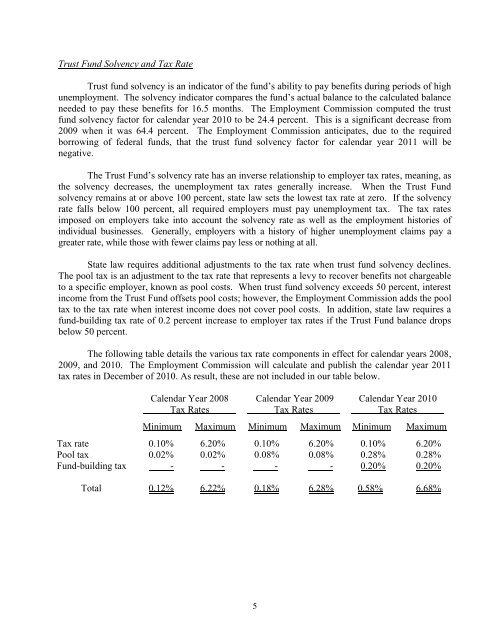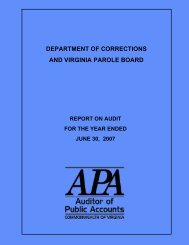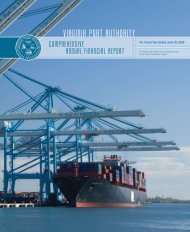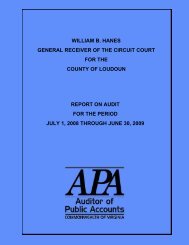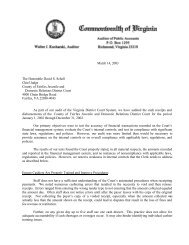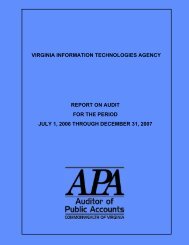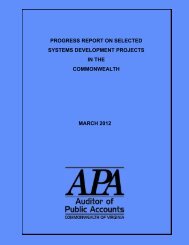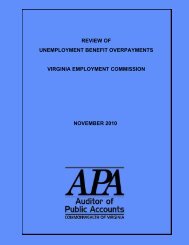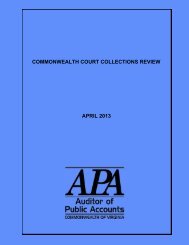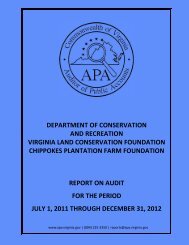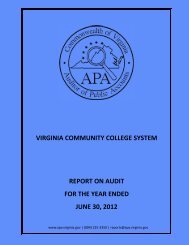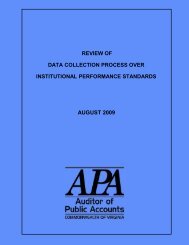Virginia Employment Commission for the year ended June 30, 2010
Virginia Employment Commission for the year ended June 30, 2010
Virginia Employment Commission for the year ended June 30, 2010
Create successful ePaper yourself
Turn your PDF publications into a flip-book with our unique Google optimized e-Paper software.
Trust Fund Solvency and Tax Rate<br />
Trust fund solvency is an indicator of <strong>the</strong> fund’s ability to pay benefits during periods of high<br />
unemployment. The solvency indicator compares <strong>the</strong> fund’s actual balance to <strong>the</strong> calculated balance<br />
needed to pay <strong>the</strong>se benefits <strong>for</strong> 16.5 months. The <strong>Employment</strong> <strong>Commission</strong> computed <strong>the</strong> trust<br />
fund solvency factor <strong>for</strong> calendar <strong>year</strong> <strong>2010</strong> to be 24.4 percent. This is a significant decrease from<br />
2009 when it was 64.4 percent. The <strong>Employment</strong> <strong>Commission</strong> anticipates, due to <strong>the</strong> required<br />
borrowing of federal funds, that <strong>the</strong> trust fund solvency factor <strong>for</strong> calendar <strong>year</strong> 2011 will be<br />
negative.<br />
The Trust Fund’s solvency rate has an inverse relationship to employer tax rates, meaning, as<br />
<strong>the</strong> solvency decreases, <strong>the</strong> unemployment tax rates generally increase. When <strong>the</strong> Trust Fund<br />
solvency remains at or above 100 percent, state law sets <strong>the</strong> lowest tax rate at zero. If <strong>the</strong> solvency<br />
rate falls below 100 percent, all required employers must pay unemployment tax. The tax rates<br />
imposed on employers take into account <strong>the</strong> solvency rate as well as <strong>the</strong> employment histories of<br />
individual businesses. Generally, employers with a history of higher unemployment claims pay a<br />
greater rate, while those with fewer claims pay less or nothing at all.<br />
State law requires additional adjustments to <strong>the</strong> tax rate when trust fund solvency declines.<br />
The pool tax is an adjustment to <strong>the</strong> tax rate that represents a levy to recover benefits not chargeable<br />
to a specific employer, known as pool costs. When trust fund solvency exceeds 50 percent, interest<br />
income from <strong>the</strong> Trust Fund offsets pool costs; however, <strong>the</strong> <strong>Employment</strong> <strong>Commission</strong> adds <strong>the</strong> pool<br />
tax to <strong>the</strong> tax rate when interest income does not cover pool costs. In addition, state law requires a<br />
fund-building tax rate of 0.2 percent increase to employer tax rates if <strong>the</strong> Trust Fund balance drops<br />
below 50 percent.<br />
The following table details <strong>the</strong> various tax rate components in effect <strong>for</strong> calendar <strong>year</strong>s 2008,<br />
2009, and <strong>2010</strong>. The <strong>Employment</strong> <strong>Commission</strong> will calculate and publish <strong>the</strong> calendar <strong>year</strong> 2011<br />
tax rates in December of <strong>2010</strong>. As result, <strong>the</strong>se are not included in our table below.<br />
Calendar Year 2008<br />
Tax Rates<br />
Calendar Year 2009<br />
Tax Rates<br />
Calendar Year <strong>2010</strong><br />
Tax Rates<br />
Minimum Maximum Minimum Maximum Minimum Maximum<br />
Tax rate 0.10% 6.20% 0.10% 6.20% 0.10% 6.20%<br />
Pool tax 0.02% 0.02% 0.08% 0.08% 0.28% 0.28%<br />
Fund-building tax - - - - 0.20% 0.20%<br />
Total 0.12% 6.22% 0.18% 6.28% 0.58% 6.68%<br />
5


